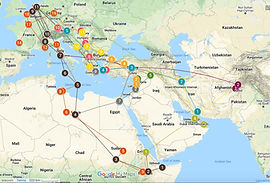ISSUE #9
Vehicles of mobility: Transportation & migration infrastructures
Migration is not only about the movement of humans; vehicles, roads and routes play a central role in shaping journeys, facilitating or hindering the circulation of humans and objects. Infrastructures are an instrument for communication and engagement, connecting sending and receiving societies and diasporas over the distance, or helping newcomers navigate their community. But they can also build barriers to movement and enforce separation and immobility, acting like a selective screen for people on the move. From aeroplanes carrying migrants, tourists and deportees across borders, to the various watercrafts (migrant boats, rescue ships and coast guard vessels) that constitute hazardous seascapes such as the Mediterranean, as well as the trains, cars and trails crossing land borders, vehicles create radically different conditions and experiences for travellers.
Adapting to a particular geographic context, infrastructures are also intrinsically linked to notions of security and economics. They are shaped by divisions of class, race and legal status, and in turn produce new distinctions between mobile and immobile subjects, deciding who can move and how, and bringing about a series of political, social, and economic consequences in the aftermath of crossing borders.
In this issue, we reflect on different infrastructures, some more visible than others: we stop at border controls between Hungary and Serbia or Zimbabwe and South Africa, follow the train transporting Central American migrants through Mexico, and map the laws and technologies that carve the journeys to Europe across and beyond the Mediterranean. Many of the pieces in this issue analyse human mobility and the structures shaping it through art forms and personal testimonies: a photo essay follows closely the lives of two Sudanese refugees in France, and three film reviews take us through media representations of migration, mental health challenges for asylum seekers, and the work of a grassroots organisation assisting migrants en route.
When we started planning this issue months ago, we did not know that a global pandemic would soon spread tragically, making the role of infrastructures in enforcing immobility more salient than ever through lockdowns and border shutdowns. We would like to extend a word of appreciation to our writers for staying with us and seeing this issue through in such a tough time for everyone. To our readers: please stay safe, remain home if you can, and take care of each other – from a distance.











